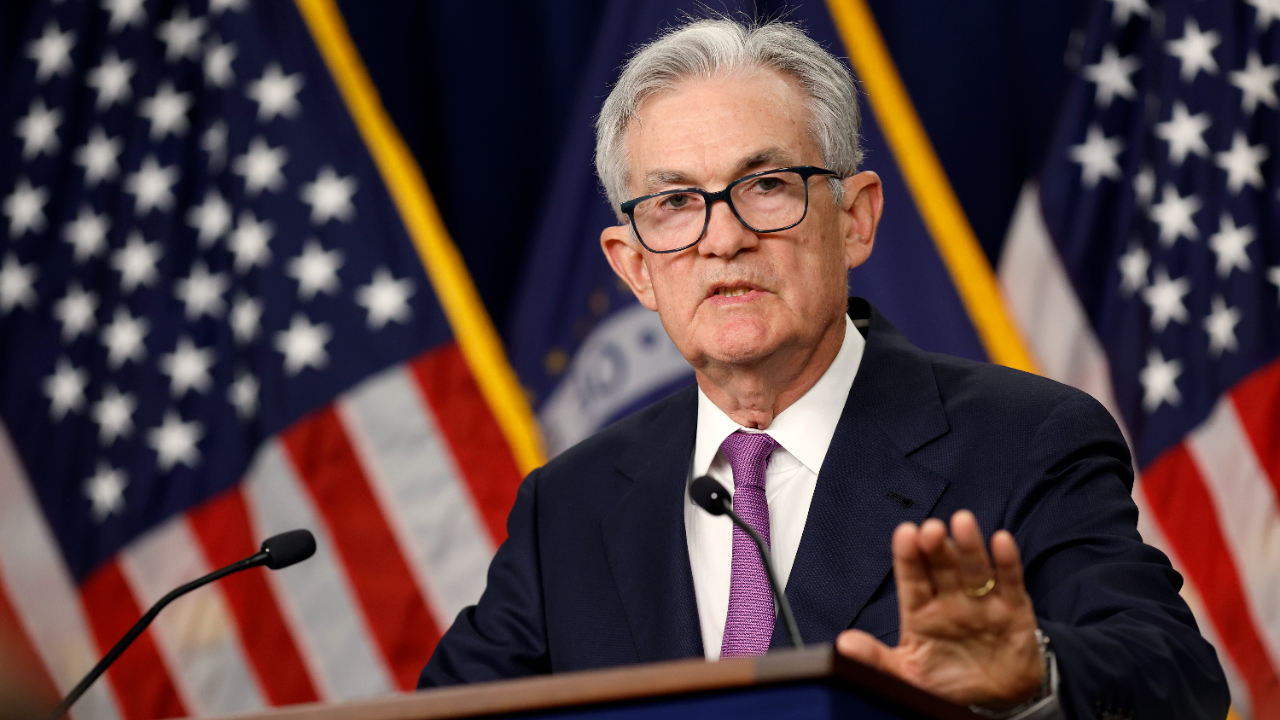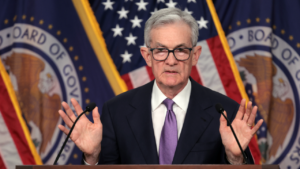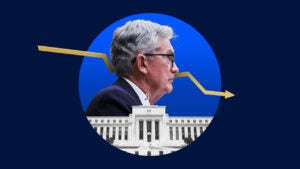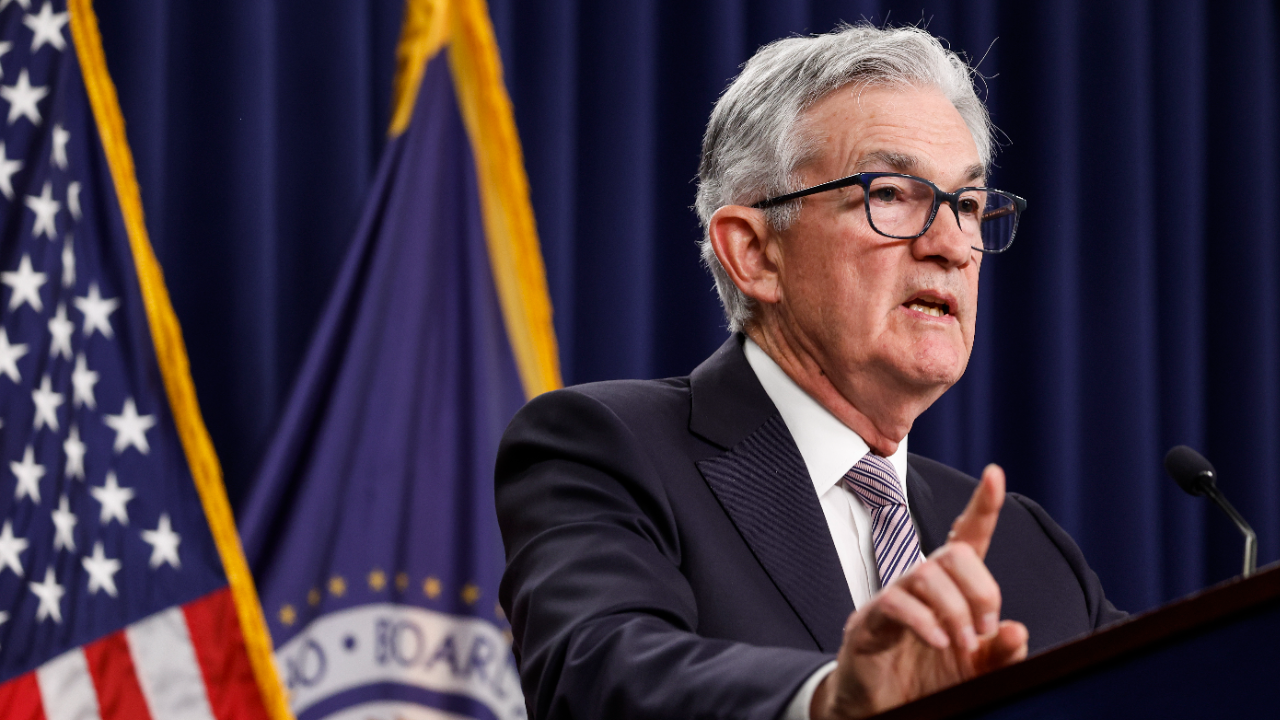Fed keeps interest rates at 22-year high as economy stays surprisingly strong

The Federal Reserve held off on raising interest rates for the second meeting in a row, a move that gives officials more time to assess the U.S. economy’s surprising strength and just how much a massive surge in long-term interest rates could weigh on the financial system.
The Federal Open Market Committee (FOMC) left its key benchmark that guides the costs consumers pay to borrow money in its current target range of 5.25-5.5 percent, where it’s been since the Fed’s last rate hike in July. It marks another slowdown in the Fed’s forceful inflation fight, which kicked off in March 2022 at a time when borrowing costs were near zero and inflation was boiling — while still getting hotter.
The Fed pushed interest rates to that level — a 22-year high — in a historically short amount of time. Not since the 1980s have U.S. central bankers lifted borrowing costs in a single tightening campaign by more than 4 percentage points.
Meanwhile, if its projections from September end up becoming reality, the Fed could still raise interest rates another — and potentially final — time. The U.S. economy has heated up in recent months after a red-hot summer of consumers spending big on items such as concert tickets and vacations. The U.S. economy grow at its fastest speed since 2021 in the third quarter, and even hiring demand has remained feverish. Last month, employers created the most new jobs since January, while job openings edged up for the second month in a row.
That’s not what experts expected to happen. At this time last year, economists projected that the U.S. economy would almost certainly be in a recession by now. The odds of a downturn occurring in the third quarter of 2023 hit 65 percent in Bankrate’s quarterly economists’ poll from a year ago.
The stronger-than-expected economy could end up making the Fed’s goal of slowing down inflation even harder. But the Fed is facing risks on both sides, including the chances that it could overdo it on rate hikes. The 10-year Treasury yield surged to the highest levels since 2007 as October came to a close and even briefly broke 5 percent. That rate is another key borrowing benchmark that could influence anything from a company’s ability to finance an expansion to a consumer’s cost when financing a home.
In changes to their post-meeting statement from their latest gathering, Fed officials acknowledged that “credit” conditions are also now “likely” to weigh on the economy, suggesting policymakers see it doing some of the Fed’s work for it.
Monetary policy has always been known to act with a lag, but the ultimate fear is that officials might not know they’ve done enough to slow price pressures until it’s too late. A tough journey lies ahead for Fed officials, who are hoping higher interest rates don’t have to come at the economy’s expense.
“Maybe this is as high as interest rates will get, but even if that proves to be the case, it is far too early for the Fed to admit as much,” says Greg McBride, CFA, Bankrate chief financial analyst. “To have the full effect of keeping interest rates higher for longer, the Fed will maintain a posture that rates could go higher and that any rate cuts are quite a ways off.”
The Fed’s rate decision: What it means for you
Savers
The Fed isn’t hiking interest rates as fast as it once was, but savers still have some wins ahead of them. Slowing inflation, coupled with historically high interest rates, is affording consumers the opportunity to not just safeguard their purchasing power but grow it — all with minimal risk thanks to Federal Deposit Insurance Corp. (FDIC) protections.
Americans don’t need to be reminded of the effects of inflation, after a post-pandemic burst made the items people both want and need unaffordable. At an annual inflation rate of 3.7 percent, for example, you’d need about $5,185 next year to afford the same goods and services that would’ve cost you $5,000 this year.
But with one of the top-yielding savings accounts for November, savers could earn an annual percentage yield (APY) as high as 5.4 percent. Thanks to that offer, your $5,000 at risk of inflation today would be worth $5,200 a year from now.
Right now, that’s just a marginal win — a difference of $5 when accounting for the current level of inflation. But the more inflation falls this year, the bigger those wins will become.
Fed officials see inflation hitting 2.6 percent by the end of 2024, a year when they’re only currently expecting to cut their benchmark borrowing rate by 50 basis points — likely keeping yields high.
A high-yield savings account can be an accessible home for your emergency fund, a crucial cushion of cash that could save you from incurring high-interest credit card debt if an unexpected expense or layoff pops up. Thanks to yields that are currently nine times the national average, that crucial pile of cash you save for a rainy day will grow even quicker.
Meanwhile, the savers who’ve already built up an emergency fund should consider complementing their portfolio with a longer-term certificate of deposit (CD). Five-year CDs are currently hitting an APY as high as 4.75 percent, while 2-year CDs are paying an APY of 5 percent. But once the Fed’s latest rate-hiking cycle looks like it’s in the rearview mirror, banks may start to nudge those offers even lower.
Borrowers
When the Fed raises rates, borrowing costs rise on almost every type of loan, from car loans and credit cards to variable-rate mortgages and personal loans. But a Fed on pause since July hasn’t made the borrowing environment any easier. By some standards, it’s only grown tighter and pricier.
Credit card rates hit another record high of 20.72 percent annual percentage rate (APR) in early October, while retail store cards are even higher. Home equity lines of credit are higher than 9 percent APR, and home equity loan rates have jumped 26 basis points since the Fed’s last meeting — even though it didn’t raise interest rates.
The price of borrowing money is unlikely to get more affordable until the Fed begins cutting interest rates — moves that could still be a ways in the distance as inflation stays stubbornly above officials’ 2 percent goalpost.
Interest rates could be even higher depending on your borrowing history and credit score. Financial firms could also tighten the belt on lending as the money supply shrinks and monthly loan payment costs soar.
But not everyone has the luxury of timing the market. If you’re planning to borrow soon, concentrate on keeping strong-to-excellent credit to set yourself up for lenders’ best offers and rates.
Your next move should be eliminating high-interest credit card debt. Balance transfer cards on the market offer 0 percent introductory annual percentage rates (APRs) for up to 21 months — giving you time to craft a debt-payoff game plan and limit how much you’re spending on interest alone.
Homebuyers
Homebuyers are feeling all the pain of higher interest rates — and none of the supposed gains.
Mortgage rates are soaring to new highs, breaching 8 percent on Oct. 25 for the first time since 2000. But those higher rates — initially thought to be the cure for the most competitive housing market in U.S. history — are only exacerbating affordability problems. Adding to other existing inventory challenges, the buyers who were lucky enough to lock in a mortgage rate below 3 percent during the pandemic era are deciding to stay put.
A $500,000 30-year mortgage would’ve cost $2,089 in principal and interest back in January 2022, before the Fed started raising rates, according to Bankrate’s mortgage calculator. That monthly payment would now be $3,672 — a 76 percent jump — if a homebuyer locked in a 30-year fixed-rate mortgage at 8.01 percent.
After declining for seven straight months, home prices have now climbed each month for the same amount of time, officially hitting a new record high in August, according to the S&P Case-Shiller Home Price Index.
It’s clear that higher mortgage rates are weighing on demand. Sales volumes, for example, have dropped consistently since the 30-year fixed-rate mortgage began surging, National Realtor Association data shows.
But it all suggests homebuyers are going to keep facing a new, tougher era for the housing market — one with higher rates, higher costs and less supply.
You can still take steps to set yourself up for success in buying a home when the time is right. Pay down debt, bolster your income opportunities and stash cash away for a future down payment.
Investors
It’s been a bumpy ride for the stock market this October, thanks to a massive surge in longer-term interest rates that had investors jittery about both rising government debt and economic growth.
To wrap up a volatile week of trading, the S&P 500 on Oct. 27 slid more than 10 percent from its July high, the threshold typically categorized as a “correction.” Asset prices are also in their third month of declines, as the U.S. central bank stays aggressive on interest rates.
It might not always stay this way. For most of the year, investors have looked past the most hawkish Fed in decades, and the key stock index is still up about 10 percent since the start of the year.
But from the long-term investor’s perspective, the best time to buy stocks is often when they go on sale. Trimming back on your contributions to your retirement account could leave thousands, if not hundreds of thousands, of dollars on the table by the time you hope to exit the workforce, thanks to compound interest. Stay the course with a diversified portfolio of investments, know that downdrafts in the market are just part of the economic cycle and remember that the Fed’s ultimate goal in raising interest rates is to keep inflation from becoming a much greater threat later on.
When will the Fed decide enough is enough on raising interest rates?
The most important next phase for monetary policy is deciding at what level rates are going to be “sufficiently restrictive” to bring inflation down to 2 percent, Fed Chair Jerome Powell indicated in a post-meeting press conference.
“We’re not confident at this time that we’ve reached such a stance,” Powell said. “We’re not confident that we haven’t, and we’re not confident that we have.”
Higher Treasury bonds could only assist the Fed in its quest to defeat inflation if tighter financial conditions remain “persistent,” Powell said. Day-to-day fluctuations — as is often the case in financial markets — would not give policymakers the confidence that surging yields are doing the job.
The tough part is gauging what “sufficiently restrictive” looks like in an economy that doesn’t seem close to slowing down. Powell added that staff members at the Fed’s board of governors are still not currently forecasting a recession, even after penciling it in as their base case in economic remarks delivered to policymakers in their May and June meetings.
Inflation has fallen from a high of 9.1 percent to its current 3.7 percent level. Interest rates have jumped 500 basis points to 5.25-5.5 percent. Job openings are down 21 percent from their peak in March 2022, and at one point, those vacancies were down as much as 26 percent. All the while, unemployment has held below 4 percent.
“That’s a historically unusual and very welcome result,” Powell said.
Supply-related factors — which are outside of the Fed’s control — could be one reason why the slowdown in inflation so far hasn’t caused much economic pain. The labor force has grown by nearly 3 million so far this year, Labor Department data shows, while manufacturing disruptions and shipping bottlenecks aren’t pushing up goods prices as much as they once were.
But Powell also indicated resilient demand could be part of what’s still pushing up prices — and that’s an inflation-causing ingredient the Fed can control.
“Those things will run their course, and we’re probably still going to be left with some ground to cover,” Powell said. “Slowing down is giving us a better sense of how much more we need to do and if we need to do more.”
Fewer than 1 in 5 investors (or 17 percent) are expecting the Fed to raise rates in December. The rest (roughly 83 percent) are projecting officials will keep rates steady, according to CME Group’s FedWatch tool. Most investors also aren’t expecting the Fed to cut rates until June 2024.
For now, the Fed may want to keep the waters calm as they decide whether to adjust borrowing costs anymore. The Fed will get to look at two jobs and inflation reports before its final gathering of the year Dec. 12-13.
Officials may actually end up prompting more market volatility if they commit to a policy path, according to Erik Weisman, chief economist and portfolio manager at MFS Investment Management who formerly worked for the Treasury Department.
“They’re not being forced by events right now to have to make that decision, so there’s no reason to preempt it,” Weisman says. “If everyone is somewhat comfortable being here for a little while, I’m not sure the Fed wants to rock the boat.”
You may also like

Fed lowers interest rates with surprising jumbo half-point cut




